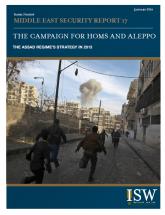 |
 |
The Campaign for Homs and Aleppo

Executive Summary
The Assad regime’s military position is stronger in January 2014 than it was a year ago and remains committed to fighting for Damascus, Homs, and Aleppo. Nonetheless, the conflict remains at a military and political deadlock.
In the spring of 2013 the regime lacked the necessary manpower to conduct simultaneous operations on multiple fronts against rebel groups that were quickly making gains throughout the north, south, and Damascus countryside. The Syrian Arab Army (SAA) had sustained more losses than it could replenish. It relied on air assets to resupply besieged troops in its Aleppo and Idlib outposts because it lacked overland logistical lines connecting those outposts. The regime had contracted its military footprint to Damascus and Homs in order to its secure supply lines while rebels contested Homs, the lynchpin of the regime’s logistics system that connected Damascus to Aleppo and to the coast.
The Syrian regime has since been resuscitated by infusions of men and materiel from Iran, Hezbollah, and Russia and from the formalization of pro-regime militias under the National Defense Forces. This report will lay out the changes in the regime’s strategy and conduct of the campaign that allowed it to regain some of its strength. It will also lay out how opposition movements have attempted to conduct multiple, sometimes competing campaigns of their own against the regime.
Beginning with the al-Qusayr offensive in 2013, the regime demonstrated the capacity to overcome its manpower deficit and inability to fight simultaneously on multiple fronts. It also illustrated the regime’s strategy to defeat the opposition by isolating rebel systems from their supply lines, attacking by fire, then clearing and holding terrain. The government offensive at al-Qusayr in April 2013 highlights these principal characteristics of the regime’s new campaign with the clear orientation of regime assets to support a decisive battle at al-Qusayr.
Meanwhile, the opposition did not unite under the direction of the Supreme Military Council (SMC) of the Free Syrian Army (FSA). The SMC struggled to maintain authority over a host of rebel groups, to direct the allocation of resources to strategic priorities, and to orient the opposition to achieve operational goals. After the United States decided not to intervene in the wake of the chemical weapons strike in Damascus, many powerful groups denounced the SMC and formed new alliances.
Despite a lack of national-level command and control on the part of the rebels, the resilience of rebel systems, guerilla tactics, and effective attacks by groups such as ISIS have prevented the regime from uprooting the armed opposition from the country or even from major cities, including Damascus and Aleppo. The resiliency of the opposition stems largely from its decentralization. Rebel support and attack zones have created multiple centers of gravity for the opposition, thus diversifying the risk of systemic collapse faced by rebel groups when the regime attacks on any given front. Rebel infighting, which escalated in January 2014, diminishes the advantages gained from this dispersion.
The regime’s growing strength and the growing extremism of the al-Qaeda affiliates has pushed the Syrian opposition to evolve, leading to a drive for unification among the internal fighting forces, independent of the political leadership-in-exile, which has failed to provide the amount of support that the fighting groups have needed. Smaller, scattered, local rebel brigades have continued to announce mergers throughout 2013, particularly in the months since the August 21st chemical weapons attack – most notably the formation of the Islamic Front was announced on November 22. By promising to pull together some of Syria’s most effective fighting forces under one banner, the new Islamic Front has the potential to effectively coordinate rebel groups on the ground.
In 2014 the regime has the ability to wage campaigns on multiple fronts nearly simultaneously or in quick succession. This capacity is first and foremost the result of additional manpower from Hezbollah and National Defense Forces. In addition, the regime has gained the ability to design as well as execute multiple, sequential and simultaneous operations, aided perhaps by the increase in reliable command and control elements including advisors. This requires the regime to consider the priorities of its coalition partners in designating priority efforts.
Despite the regime’s apparent resurgence and the opposition’s enduring challenges, the Assad Regime is not winning the Syrian civil war, and it does not have the strength to win decisively in 2014. Lacking that ability, the regime continues to use tactics that contravene the law of armed conflict, such as the deliberate mass killing of civilians in the August chemical weapons strike; the use of barrel bombs to kill civilians in December in Aleppo; and the deliberate starvation of populations in Damascus.